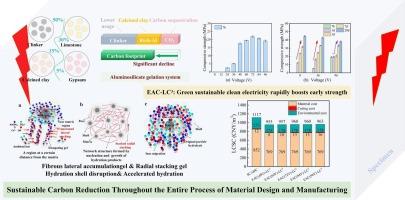电活化可持续富铝水泥复合材料多尺度性能演化及生态效益分析
IF 9.2
2区 工程技术
Q1 ENERGY & FUELS
引用次数: 0
摘要
水泥行业是全球二氧化碳(CO2)排放的主要来源,促使人们寻找低碳替代品。石灰石煅烧粘土水泥(LC3)具有熟料含量低、养护过程低碳的特点,是一条很有前途的发展道路。然而,低熟料导致的LC3早期强度较低限制了建筑材料的使用。本研究通过将清洁能源电活化固化(EAC)与低碳LC3相结合的方法,解决了减碳和低早期强度的需求,建立了从材料配方到固化的全面减碳途径。结果表明,在压控实验中,将固化电压从24v提高到72v可使7 h抗压强度提高7.7倍。一个小的冲击位移被注意到,较低的电压鼓励水化凝胶包裹的侧向沉淀,而较高的电压诱导径向沉积,导致更致密的微观结构。生命周期评价(LCA)表明,EAC-LC3的环境影响分别降低了29.7% (GWP)、11.5% (ADP化石)、33.7% (AP)、28.4% (EP)和27.4% (POCP),生命周期可持续成本(LCSC)降低了13.8%。对富铝系统中电压调制凝胶形成机制的深入研究,以及已证明的环境和经济效益,支持采用这种创新的低碳建筑方法。本文章由计算机程序翻译,如有差异,请以英文原文为准。

Multiscale performance evolution and eco-efficiency analysis of sustainable alumina-rich cement composites cured by electric activation
The cement industry is a major source of global carbon dioxide (CO2) emissions, driving the search for low-carbon alternatives. Limestone calcined clay cement (LC3), with its reduced clinker content and low-carbon profile during curing, offers a promising route. However, the lower early-age strength of LC3 related to low-clinker limits the use of construction materials. This study addresses the needs for carbon-reduction and low early-term strength, through the method combining clean-energy electric-activation curing (EAC) with low-carbon LC3 to establish a comprehensive carbon-reduction pathway from material formulation through curing. Result shows that increasing the curing voltage from 24 V to 72 V amplifies 7 h compressive strength by a factor of 7.7 in voltage-controlled experiments. A small impact shift is noticed that lower voltages encourage wrapped lateral precipitate of hydration gels, whereas higher voltages induce radial deposition, resulting in a denser microstructure. Life cycle assessment (LCA) indicates that the environmental impacts of EAC-LC3 reduced by 29.7 % (GWP), 11.5 % (ADP fossil), 33.7 % (AP), 28.4 % (EP), and 27.4 % (POCP), respectively, and the life cycle sustainable cost (LCSC) reduced by 13.8 %. Insights into voltage-modulated gel-formation mechanisms in alumina-rich systems, together with demonstrated environmental and economic benefits, support the adoption of this innovative low-carbon construction approach.
求助全文
通过发布文献求助,成功后即可免费获取论文全文。
去求助
来源期刊

Sustainable Materials and Technologies
Energy-Renewable Energy, Sustainability and the Environment
CiteScore
13.40
自引率
4.20%
发文量
158
审稿时长
45 days
期刊介绍:
Sustainable Materials and Technologies (SM&T), an international, cross-disciplinary, fully open access journal published by Elsevier, focuses on original full-length research articles and reviews. It covers applied or fundamental science of nano-, micro-, meso-, and macro-scale aspects of materials and technologies for sustainable development. SM&T gives special attention to contributions that bridge the knowledge gap between materials and system designs.
 求助内容:
求助内容: 应助结果提醒方式:
应助结果提醒方式:


